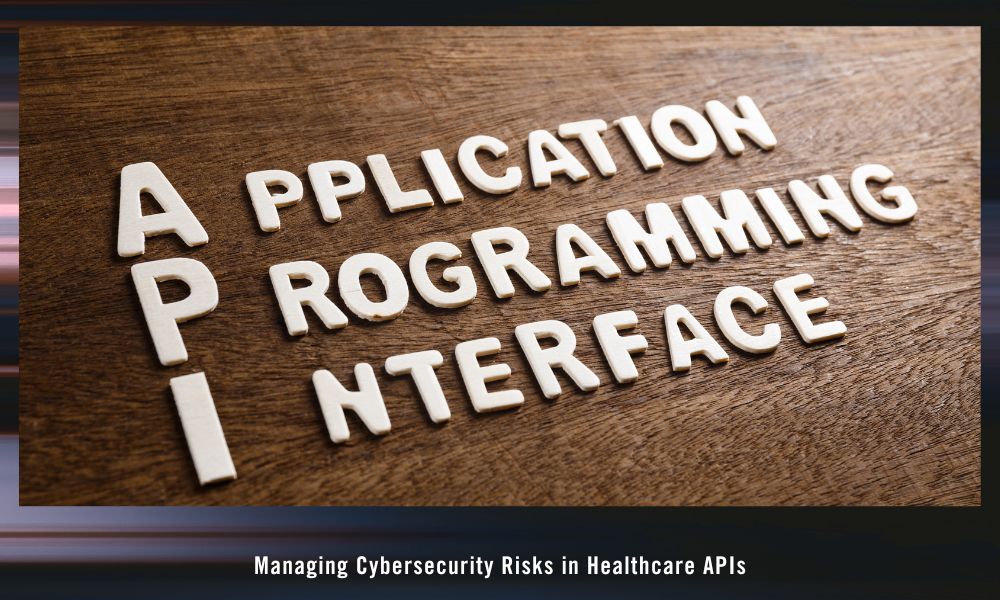What Are Healthcare APIs and Why Do They Matter?
In This Post
Application Programming Interfaces (APIs) serve as the unseen messengers quietly ferrying data between systems. APIs are frequently used in healthcare to provide automatic data sharing between various systems. APIs ensure that a physician’s click in a patient portal retrieves lab results from an electronic health record (EHR) or that diagnostic imaging results flow seamlessly into a hospital’s clinical dashboard.
These connections facilitate data exchange that improves patient care, reduces administrative burden, and enables real-time clinical decision-making. But as with any open gate, APIs also present risk.
Because data flows involve protected health information (PHI), the stakes are significantly higher. APIs can serve as gateways to networks and software, allowing threat actors to attack an entire healthcare network.
Since APIs handle the use and disclosure of protected health information, maintaining HIPAA compliance becomes an essential aspect of security that must be continuously monitored and addressed.
Understanding Application Programming Interfaces
Application programming interfaces (APIs) are sets of protocols and tools that enable different software applications to communicate and exchange data seamlessly. These digital contracts specify exactly how software components should interact, defining request formats, response structures, and the methods for accessing specific functionality or data resources.
APIs drive $2.2 trillion in revenue globally and enable 83% of web traffic, making them critical infrastructure for microservices architecture, cloud computing, and digital business models.
The Role of APIs in Modern Healthcare Data Exchange
APIs are essential building blocks of modern digital infrastructure, powering everything from mobile apps to cloud services, and connecting everything from patient portals to EHR systems to diagnostic systems. Common types of healthcare APIs include:
- Electronic health records
- Telemedicine
- Medical imagining
- Laboratory test results
- Prescription management
- Billing and claims
- Appointment scheduling
- Secure communication
However, patient information is often stored in a variety of systems across different information exchanges such as laboratory EHRs, pharmacy EHRs, and clinic EHRs. This fragmented system means APIs serve as connection points for sending and retrieving information, thereby making patient data readily accessible.
How APIs Connect Patient Portals, EHRs, and Diagnostic Systems
Patient Portals to EHRs
Patient portals are the public-facing gateways for individuals to view lab results, schedule appointments, or message providers. Behind the system, multiple APIs work to facilitate these interactions between the portal and the EHR system.
Here’s how it typically works:
- A patient logs in to their portal. The system authenticates the user and requests their information through an API.
- The API queries the EHR database, retrieves only the authorized data, such as recent lab results or medication lists, and returns it to the portal interface.
- The patient views their data in real time, without the need for separate databases or redundant data entry.
By design, APIs ensure that the patient portal doesn’t store the information. It displays the information from the EHR, reducing the risk of duplicate or outdated records.
EHRs and Diagnostic Systems
Hospitals and clinics often rely on multiple systems: imaging software for radiology, laboratory information systems (LIS), and EHRs for clinical documentation. APIs ensure these systems communicate with each other, transmitting diagnostic data back and forth instantly.
For example:
- A radiologist uploads a completed MRI study into a diagnostic imaging system.
- An API call pushes the study’s results and metadata (patient ID, test type, findings) into the EHR.
- The ordering physician can now view the report directly within the patient’s chart.
Types of Healthcare APIs
- Internal APIs: are used within a single healthcare organization to connect its own systems, such as linking the EHR to billing or scheduling tools. Because they operate behind the organization’s firewall, internal APIs improve efficiency and interoperability without exposing data to outside entities. However, they still require strict access controls and monitoring since they handle sensitive patient information.
- External APIs: enable data exchange between a healthcare organization and outside partners, such as laboratories, pharmacies, or health information exchanges. These APIs extend interoperability beyond the organization’s network, supporting care coordination and faster information sharing. Since external APIs transmit data across organizational boundaries, they require encryption, authentication, and audit logging to maintain HIPAA compliance.
- Third-Party APIs: are developed and managed by vendors or external service providers. For example, telehealth platforms, mobile health apps, or cloud-based diagnostic tools that integrate with an EHR. While they enhance functionality and innovation, they also introduce higher security and compliance risks. Third-party APIs must be vetted and require a Business Associate Agreement (BAA) to ensure that the vendor adheres to the same HIPAA safeguards the healthcare organization maintains.
HIPAA and the Security Rule: Guardrails for the Digital Age
The Health Insurance Portability and Accountability Act (HIPAA) Security Rule is the bedrock of data protection in healthcare. It requires covered entities and their business associates to ensure the confidentiality, integrity, and availability of electronic protected health information (ePHI).
The HIPAA Security Rule sets the concept that security is not a static state but an ongoing process of risk management. It encompasses the process of conducting Security Risk Analysis, sometimes referred to as a security risk assessment. A security risk analysis ensures that a healthcare organization’s systems and processes implement safeguards that comply with the specifications outlined in the Security Rule.
A Security Risk Analysis requires healthcare organizations to:
- Identify where ePHI is created, received, maintained, or transmitted
- Assess potential threats and vulnerabilities to ePHI data
- Determine the likelihood and potential impact of those threats
- Implement security measures proportionate to the risk
- Review and update their security assessments regularly as systems and technologies evolve
In the world of APIs, this means understanding exactly what data is shared, where it travels, and who or what can touch it along the way.
Why the HIPAA Security Rule Applies to API Use
HIPAA requires data integrity throughout the data lifecycle. And healthcare providers rely on accurate and trustworthy data to make informed medical decisions.
APIs fall under the same organizational policies and oversight as any other system handling ePHI. Because APIs handle or transmit ePHI, they must be part of a security risk assessment and meet HIPAA’s requirements for data integrity.
That means that APIs that handle or transmit ePHI should remain accurate, complete, and trustworthy, and meet the following aspects:
- Confidentiality: only authorized users and applications can access PHI.
- Integrity: data shared through APIs is accurate and remains trustworthy from unauthorized alteration or destruction.
- Availability: systems are resilient, and data remains accessible to those who need it for care delivery.
APIs need to be identified and mapped to the PHI or other sensitive data they use, and periodically evaluated to ensure the interfaces remain secure. In many instances, interfaces are beyond the control of healthcare providers, as they are developed by the vendors of the various software systems or applications they use.
Healthcare providers should conduct an inventory of the APIs in use and regularly consult with vendors or software system providers to verify their security. There is emerging technology available that can offer external evaluation and testing of these APIs and can even alert providers when they are being misused by threat actors.
Common API Security Threats in Healthcare Systems
Inadequate Authentication and Authorization:
When APIs fail to properly verify who is accessing them or what that user is allowed to do, they can inadvertently compromise sensitive patient data. Weak credential systems, shared tokens, or missing access controls allow cybercriminals to impersonate legitimate users or applications, slipping into the network unseen.
Excessive Data Exposure and Weak Encryption:
When APIs return more information than necessary, they contribute to excessive data exposure, allowing attackers to harvest PHI piece by piece. Pair this with unencrypted or poorly encrypted data in transit that can be intercepted, and the risk to PHI exposure multiplies.
Risks of Third-Party and Vendor APIs:
When healthcare organizations use third-party and vendor APIs, they have limited control, which introduces external risks. Many third-party APIs lack rigorous encryption, logging, or access limitations, making them soft targets for attackers. When a vendor’s API connects directly to an EHR or patient database, a single security flaw on their end can become a healthcare organization’s breach.
The HIPAA Minimum Necessary Standard and API Data Sharing
Under the HIPAA Privacy Rule, covered entities must follow the minimum necessary standard, meaning they can only use, disclose, or request the minimum amount of PHI needed to accomplish a specific purpose.
Since APIs facilitate the use and disclosure of PHI, they should be configured to limit data exposure, returning only the fields required for a given task rather than entire patient records.
For example, a scheduling app’s API might need access to appointment times but not diagnostic notes or medication histories. By embedding the minimum necessary rule into API permissions, access controls, and query responses, healthcare organizations reduce the risk of exposing ePHI while enabling the flow of information essential for care.
Mitigating API Risks and Staying HIPAA Compliant
To effectively mitigate API risks while ensuring HIPAA compliance, it’s essential to adopt the same rigorous approach to technical safeguards and data governance that you apply to all facets of your HIPAA security plan. By doing so, you not only protect sensitive information but also enhance the overall integrity of your security framework.
If you keep the following security management aspects in mind for APIs, you will increase your security posture:
- Use encryption and authentication protocols like OAuth 2.0.
- Enable role-based access controls to limit exposure of ePHI.
- Conduct regular security risk analysis to identify potential vulnerabilities in APIs and their integrations, including penetration testing.
- Implement risk management plans that address API-specific threats, such as data exposure and unauthorized access.
- Create clear security policies that include APIs.
- Maintain Business Associate Agreements (BAA) with any third-party vendors whose APIs handle PHI.
Together, these measures transform APIs from potential weak points into secure, compliant bridges for healthcare data exchange.
Take Control of Your API Security and Schedule a Security Risk Analysis with PrivaPlan Today
APIs are the lifelines for healthcare data, but without a thorough security risk analysis, they can also be your greatest vulnerability. Don’t wait for a breach to reveal the gaps. Call us today to schedule a comprehensive HIPAA-compliant security risk analysis. Our experts will help you identify hidden risks, strengthen your safeguards, and ensure your APIs remain secure.




